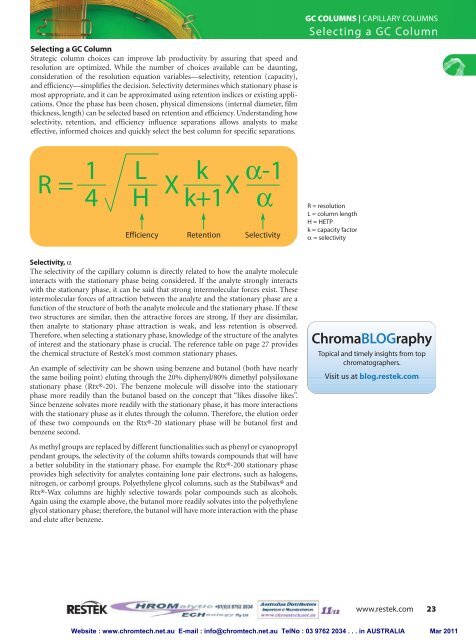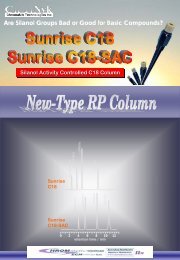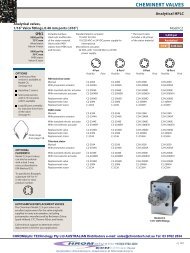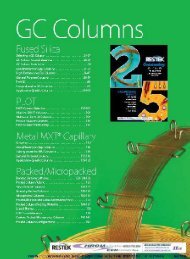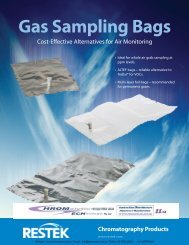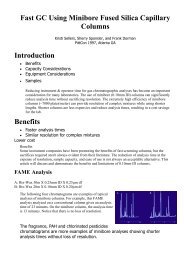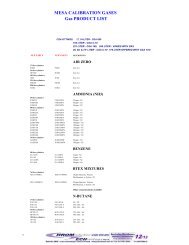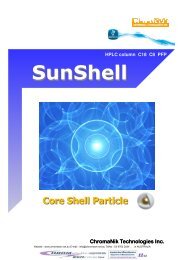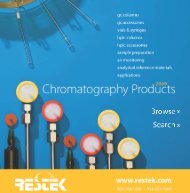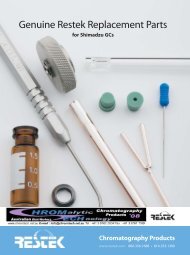You also want an ePaper? Increase the reach of your titles
YUMPU automatically turns print PDFs into web optimized ePapers that Google loves.
<strong>GC</strong> COLUMNS | CAPILLARY COLUMNS<br />
Selecting a <strong>GC</strong> Column<br />
Selecting a <strong>GC</strong> Column<br />
Strategic column choices can improve lab productivity by assuring that speed and<br />
resolution are optimized. While the number of choices available can be daunting,<br />
consideration of the resolution equation variables—selectivity, retention (capacity),<br />
and efficiency—simplifies the decision. Selectivity determines which stationary phase is<br />
most appropriate, and it can be approximated using retention indices or existing applications.<br />
Once the phase has been chosen, physical dimensions (internal diameter, film<br />
thickness, length) can be selected based on retention and efficiency. Understanding how<br />
selectivity, retention, and efficiency influence separations allows analysts to make<br />
effective, informed choices and quickly select the best column for specific separations.<br />
1 L k α-1<br />
R =<br />
4 H<br />
X<br />
k+1<br />
X<br />
α<br />
Efficiency<br />
Retention<br />
Selectivity<br />
R = resolution<br />
L = column length<br />
H = HETP<br />
k = capacity factor<br />
α = selectivity<br />
Selectivity, α<br />
The selectivity of the capillary column is directly related to how the analyte molecule<br />
interacts with the stationary phase being considered. If the analyte strongly interacts<br />
with the stationary phase, it can be said that strong intermolecular forces exist. These<br />
intermolecular forces of attraction between the analyte and the stationary phase are a<br />
function of the structure of both the analyte molecule and the stationary phase. If these<br />
two structures are similar, then the attractive forces are strong. If they are dissimilar,<br />
then analyte to stationary phase attraction is weak, and less retention is observed.<br />
Therefore, when selecting a stationary phase, knowledge of the structure of the analytes<br />
of interest and the stationary phase is crucial. The reference table on page 27 provides<br />
the chemical structure of Restek’s most common stationary phases.<br />
An example of selectivity can be shown using benzene and butanol (both have nearly<br />
the same boiling point) eluting through the 20% diphenyl/80% dimethyl polysiloxane<br />
stationary phase (Rtx®-20). The benzene molecule will dissolve into the stationary<br />
phase more readily than the butanol based on the concept that “likes dissolve likes”.<br />
Since benzene solvates more readily with the stationary phase, it has more interactions<br />
with the stationary phase as it elutes through the column. Therefore, the elution order<br />
of these two compounds on the Rtx®-20 stationary phase will be butanol first and<br />
benzene second.<br />
ChromaBLOGraphy<br />
Topical and timely insights from top<br />
chromatographers.<br />
Visit us at blog.restek.com<br />
As methyl groups are replaced by different functionalities such as phenyl or cyanopropyl<br />
pendant groups, the selectivity of the column shifts towards compounds that will have<br />
a better solubility in the stationary phase. For example the Rtx®-200 stationary phase<br />
provides high selectivity for analytes containing lone pair electrons, such as halogens,<br />
nitrogen, or carbonyl groups. Polyethylene glycol columns, such as the Stabilwax® and<br />
Rtx®-Wax columns are highly selective towards polar compounds such as alcohols.<br />
Again using the example above, the butanol more readily solvates into the polyethylene<br />
glycol stationary phase; therefore, the butanol will have more interaction with the phase<br />
and elute after benzene.<br />
www.restek.com 23<br />
Website : www.chromtech.net.au E-mail : info@chromtech.net.au TelNo : 03 9762 2034 . . . in AUSTRALIA Mar 2011


